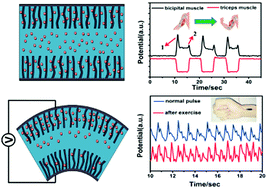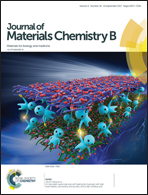Bionic ion channel and single-ion conductor design for artificial skin sensors†
Abstract
Herein, to mimic the human skin's ability to report sensing signals using ions, a novel ionic skin based on a single-ion conductor sandwiched between two carbon nanotube array electrodes was developed. Compared with the widely studied electronic skin, this flexible ionic skin could generate electrical signals without any power supply and distinguish different directions of the bending strain due to ion redistribution induced by mechanical deformation. In this study, the bionic-ordered ion channel and single-ion conductor design in the nanocomposite sensor guarantee simultaneous sensing signal (mV) under a micro-strain as small as 0.0347% with high sensitivity, stability, and linearity. The integrated wearable sensors succeed in detecting the real-time signal of human activities from large-scale deformations to subtle physiological signals including pulse wave at different frequencies and multiple modes of muscle relaxation–contraction. The present study paves a new way for designing artificial skin similar to the natural skin and developing the emerging flexible and wearable sensing platforms for healthcare and biomedical applications.



 Please wait while we load your content...
Please wait while we load your content...